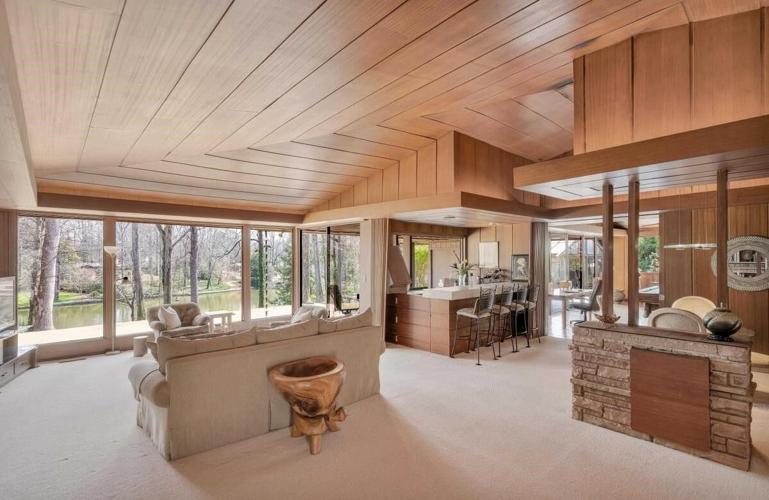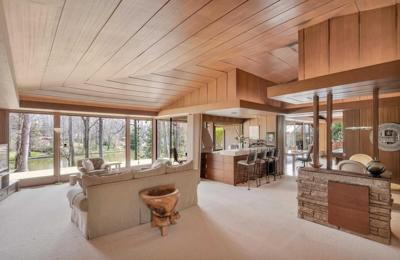GREENVILLE — The dark hardwood panels that cover the walls and ceiling are original, as is the stonework, the kitchen countertops and the rows upon rows of large windows that bring the outside in. Nestled in a leafy, established neighborhood north of downtown Greenville, the four-bedroom home at 22 Lakecrest Drive feels timeless — both in its location and its design.
Built in 1952, the 3,400-square-foot home is a prime example of mid-century modern architecture, with its wide exterior overhangs, airy rooms, huge windows, stone accents and general absence of interior ornamentation. It sits on a 1.57-acre double lot along Stone Lake, which was dug in the early 1900s, and soon became a retreat for Greenville summer camps and social clubs. Other than a few updates in the kitchen, nearly everything in the house is original, said Jacob Mann, who is handling the $2 million listing for Coldwell Banker Caine.
“This home is not just a place to sleep and eat and be with your family,” Mann said. “It’s a walk-in oil on canvas. It’s a piece of artwork.”
‘One of those special homes’
The mid-century characteristics of 22 Lakecrest Drive are evident in the board-and-batten exterior, the stacked stone that surrounds the front vestibule and the bluestone walkway that leads to the front door. The interior is swaddled in tongue-and-groove mahogany wood paneling, which is particularly striking on the ceiling. Down one side of a long hallway are a series of sliding closet doors, topped by small transom windows. A broad stone fireplace dominates a billiards room, and huge windows offer abundant views of Stone Lake.

Jacob Mann
“This is one of those special homes because it hasn’t been gutted and renovated,” Mann said. “You can look at it and pick out a lot of the signature touches that are kind of a nod to Frank Lloyd Wright.”
Wright, the godfather of mid-century modern architecture, designed one home in Greenville — Broad Margin in North Main, which was built in 1954 and today is shielded by a thick stand of trees off West Avondale Drive. But there are numerous other original mid-century homes scattered throughout established neighborhoods like Gower Estates, Parkins Mill and Botany Woods, making Greenville a rare Southern capital of mid-century design.
Of course, not every prospective homebuyer appreciates the somewhat spare look of mid-century modern design. The buyer of 22 Lakecrest “is going to have to be a purist,” Mann said.
“It’s a targeted group. But I’ve already had a couple of calls from Atlanta, we had a showing to people from California and we have some local people showing interest in it as well. This is a home for people who like to entertain and can see the art factor in it.”

A mid-century modern home built in 1952, the $2 million listing at 22 Lakecrest Drive in Greenville features original design elements such as its board-and-batten exterior and stacked stone front entryway.
A leafy escape from the city
Stone Lake Heights is a quiet, leafy enclave hidden away from the rest of Greenville. Located just outside North Main, it’s full of other classic homes from the mid-20th century — ranches, two-story Colonials, funky tri-levels, even a few other residences bearing the hallmarks of mid-century design. The home at 22 Lakecrest Drive stands out not just due to its architecture, but also because it sits on a double lot that allows it ample lake frontage and even affords room for a greenhouse on the property.
Dr. Theodore Croft Stone and his son Eugene Stone began developing the area that would become Stone Lake Heights in the early 1900s, local historian Judith Bainbridge wrote in a 2016 story in the Greenville News. Using horses and mules, a gully running through the property was excavated and a stream dammed to create Stone Lake. No houses were built then; instead, the lake became home to a lodge and pavilion that made the area a rustic retreat for locals and visitors alike.
That changed after World War II, Bainbridge wrote, when increased demand for housing led ensuing generations of the Stone family to develop the area as Stone Lake Heights, a community with 43 homesites — 17 of them on the lake itself. The neighborhood would become Greenville’s first upscale residential development since the 1920s, according to Bainbridge.
Even today, Stone Lake Heights can still feel like a timeless escape from the thriving city that surrounds it.
“It’s a little neighborhood within itself,” Mann said. “It’s kind of crazy that you have this little piece of water right there within the city. But it’s a thriving community, and people are buying houses over there and fixing them up.”













